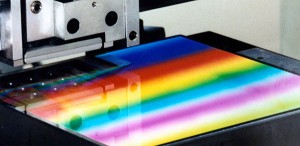DIFFRACTION GRATINGS
A grating consists of a series of equally spaced parallel grooves made on the surface of a suitable material such as polished glass or copper and over coated with a reflective material. Two types of gratings are available. Ruled gratings are made by ruling parallel grooves using precision ruling engine with diamond tool whiles holographic gratings are made using interferometer technique to produce interference fringes on a material coated with photo resist followed by developing. The distance between the adjacent grooves or fringes and the angle the grooves form with respect to the substrate surface help to determine the dispersion and efficiency of a grating. In order to maximise the performance of a grating, energy must be concentrated into one of the orders (except the zero order) as energy distribution depends on the groove shape. The principle is to rule the grating so that the reflecting groove is tilted with respect to the grating surface. For holographic gratings the profile of the sinusoidal shape is important.
Diffraction gratings employed extensively in optical resolution and calibration instruments are available for both high power lasers and non-laser applications from UV to Far-IR. Both master and replicated gratings are available on copper and glass substrates. Special CO2 laser blazed components with extremely high laser damage threshold are among the products on offer.
